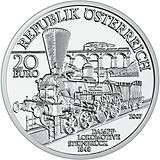Austrian Southern Railway

The Austrian Southern Railway[1] (German Österreichische Südbahn or just Südbahn,[1] Slovene Južna železnica) was an Austrian private railway company established in 1859. It was the main railway company in the Austrian Empire (from 1867: Austria-Hungary) operating train services between Vienna and Trieste until 1923.
In Austria, the term Southern Railway (Südbahn) is still used to refer to the railway lines which were formerly operated by it: from Vienna via Bruck an der Mur to Graz and via Slovenia to Trieste.
Today the term "Austrian Southern Railway" is sometimes also applied today to the railway line from Bruck an der Mur via Klagenfurt and Villach to Italy (Tarvisio), but is historically incorrect.
History
First plans for a railway connection from the Austrian capital Vienna to the Austrian Littoral and the busy Adriatic Port of Trieste, then bypassing the Eastern Alps via Bruck an der Leitha and Szombathely in Hungary, in order to meet trade demands in the upcoming age of industrialization were already set up by Franz Xaver Riepl in 1829. In 1838 Baron Georg Simon von Sina established the Wien-Raaber-Eisenbahn-Gesellschaft stock company to build a railway connection from Vienna via Wiener Neustadt to Győr (Raab) in Hungary. Construction began in 1839 and a first section between Baden and Wiener Neustadt was opened on 16 May 1841. Sina's engineer Matthias Schönerer had purchased a used steam locomotive from the Norris Locomotive Works in Philadelphia, which was shipped to Trieste and brought to Vienna by oxcart.

Meanwhile, influential circles around Archduke John of Austria had reflected about a direct railway connection crossing the Alps at the Semmering Pass. On the Lower Austrian side, the railway from Vienna via Wiener Neustadt to Gloggnitz at the foot of the mountains was completed by the private Wien-Gloggnitzer Eisenbahn Gesellschaft in 1842. On the Styrian side, the section from Graz to Mürzzuschlag opened on 21 October 1844. With effect from 1 May 1851 the public k.k. Southern State Railways took over and the construction of the section from Mürzzuschlag via Graz and Maribor and Ljubljana to Trieste was completed by the Imperial government in 1857. It included the Borovnica viaduct, one of the most imposing railway bridges of the era, built in 1856 upon the plans by Carl von Ghega. The two lines were connected by the Semmering Railway, when the railway over the Semmering mountain pass was built according to construction plans by von Ghega between 1848 and 1854.
In 1858 all lines were sold to the private Südbahn Gesellschaft, which constructed another line from Maribor via Klagenfurt, Villach and Lienz to Franzensfeste. The Austrian Southern Railway lifted trade to and from Trieste manyfold. It lifted Austria-Hungary's international sea trade and established Trieste as the main sea port of all Southern and Eastern Central Europe (Lloyd Triestino). Trieste became the Empire's fourth largest city after Vienna, Budapest and Prague and the railway had substantial influence in developing tourism along the surrounding Adriatic coasts which made Trieste the center of the so-called Austrian Riviera.
After World War I Trieste fell to Italy in 1921 and in 1923 the remaining Austrian part of the company was nationalized. During World War II the Südbahnhof was damaged and rebuilt only in 1956, while Ostbahnhof was integrated into it. Graz Main Station also had to be rebuilt after being totally destroyed by bombs, it was reopened in 1955.
During the Cold War trade between Vienna and Trieste was mainly run through Tarvisio in Italy which tracks had been equipped with electric power by 1963; the same for the branch from Vienna into Graz and Yugoslavia by 1966.
Nowadays most of the line is double track, though the line between Werndorf (South of Graz) and Maribor is still single track after having the second track removed in 1945, though this is to change in the near future.
The Southern Railway was recently selected as the main motif of a very high value collectors' coin: the Austrian Southern Railways Vienna-Triest commemorative coin, minted on September 12, 2007. The obverse shows the locomotive “Steinbrück” with one of the typical viaducts of the Semmering Railway in the background. The engine “Steinbrück” can be seen today in the Technical Museum in Vienna. It is the oldest existing locomotive built in Austria; it was constructed in 1848 for the Southern Railway.
